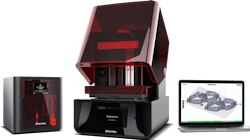Pearls for Your Practice: SprintRay Pro desktop 3-D printer
I drove a Honda Accord in dental school. It was actually a pretty good car. It was a 1997 Special Edition Accord in cherry red. It had a rad spoiler and upgraded factory rims. It was a cool car, but it was utilitarian. Like most Honda Accords, there wasn’t much in the way of amenities.
I still remember the first time I sat in a real luxury car for a test-drive. In retrospect, it wasn’t really anything that luxurious. I was shopping for a new car after I had been out of dental school for a few years and I test-drove a one-year-old Audi A6. The difference was immediately palpable—the little details of the interior finishes, the technology integration. Everything was just right. I could tell that I had just leveled up. I recently had that same experience with the SprintRay Pro desktop 3-D printer.
I have been 3-D printing in my office for several years. I purchased a stereolithography (SLA) printer back in 2016. It was cool. I mainly needed it to print models. It was slow and cumbersome, but it did what I asked it to do . . . mostly. Recently, I had the chance to use a SprintRay Pro. I immediately could tell that I had just leveled up.
I had heard great things about the SprintRay Pro. Many of my friends and colleagues have been using it for models, splints, surgical guides, and dentures for a couple of years. The number one thing I heard about is the speed at which it prints. My former printer could do a couple of arches of models in about four to five hours. That is a long time. I have found print times for the SprintRay Pro to be under one hour for several arches of models. That is ludicrously fast!
The SprintRay Pro utilizes digital light processing technology (DLP), which is what allows the fast print speeds. This custom projector allows the printer to use a uniform high-intensity light across the entire build platform. My old printer could not utilize this large of a field, making it print much slower. The large projector paired with a massive print volume allows you to print a lot in a short period of time. This is great if you are printing a series of models for aligner therapy. The SprintRay Pro will significantly decrease your time on these cases. The included RayWare software is simple, intuitive, and easy to use. I was up and going in minutes and you can be too. Training is simple. If you are a rookie to 3-D printing, allow an hour of training and you will be ready to roll.
So, the question is, do you need a 3-D printer? I think that depends on several things. Firstly, if you don’t have an intraoral scanner, you aren’t ready to print. You need a scanner that can export STL files. The next question you need to ask yourself is what you want to print.
In my practice, we do not use alginate. We can scan a patient with our iTero Element in less time than required to take an alginate. I can print a set of models in less than an hour, which is faster than it takes stone to set up. If a patient wants bleaching trays, we can be making the trays in about an hour. For us, printing models is the primary use. If you want to produce your own aligners for orthodontics, you’ll need to print a lot of models. Those are both great reasons to get into the 3-D printing game. Surgical guides are another easily printed item. If you place implants and want to do more of the digital design and planning in-house, 3-D printing can help you. I am not to the point of printing things like splints or dentures, but the capabilities are there and you can do all that with the SprintRay Pro.
This has been, by far, the best 3-D printing experience I have ever had. I have never worked with a 3-D printer as fast and elegant as the SprintRay Pro. Home run to center field!
Joshua Austin, DDS, FAGD, FACD, writes the Pearls for Your Practice column in Dental Economics. After graduating from the University of Texas Health Science Center Dental School, Dr. Austin associated for several years. In October of 2009, he opened a solo general practice in a suburban area of San Antonio, Texas. Dr. Austin is involved in all levels of organized dentistry and can be reached at [email protected].
About the Author
Joshua Austin, DDS, MAGD
Joshua Austin, DDS, MAGD, is a graduate and former faculty member of the University of Texas Health Science Center at San Antonio School of Dentistry. Author of Dental Economics’ Pearls for Your Practice column, Dr. Austin lectures nationally on products, dental technology, online reputation management, and social media. He maintains a full-time restorative dentistry private practice in San Antonio, Texas. You may contact Dr. Austin at [email protected].
Updated June 21, 2023

